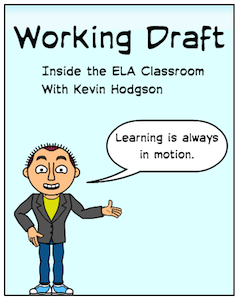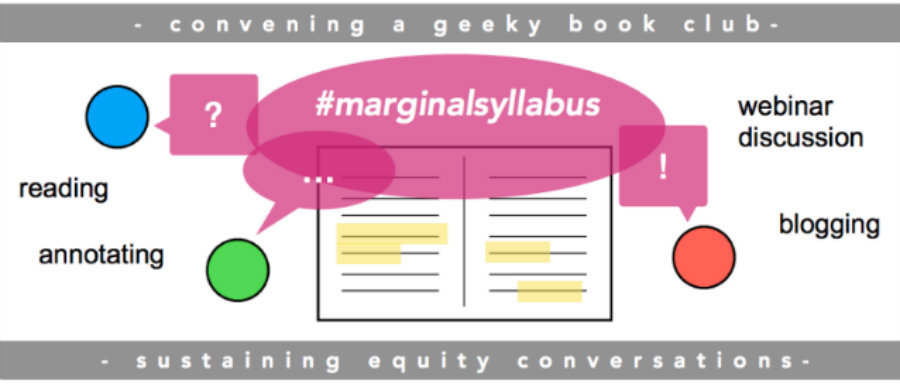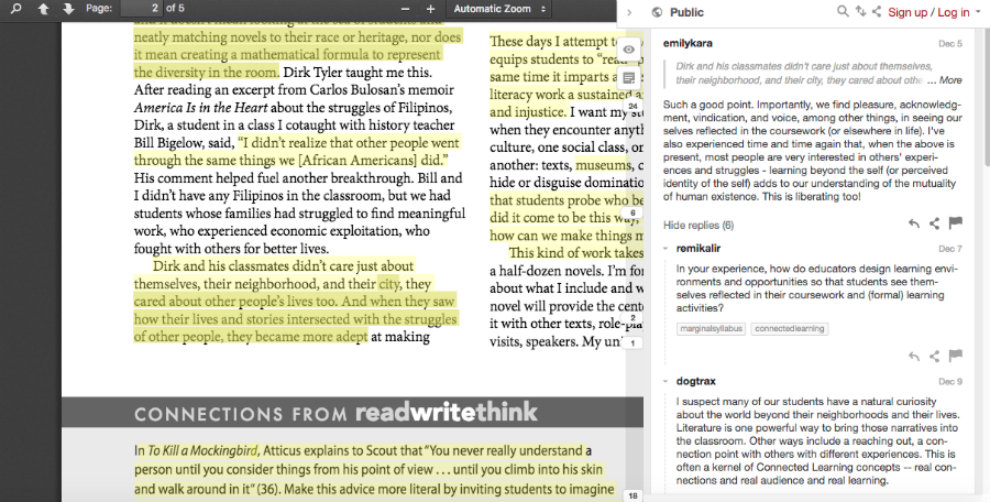Using Crowd Annotation to Close-Read the World
A MiddleWeb Blog

So says one of my friends in a social networking space where we often connect about teaching.
And I do see him in the margins, where we and many others are engaged in a “conversation” about a particular text using digital annotation. The text is on the Web. Our annotations are now layered in, off to the side.
The experience of closely reading a text, or watching a video, or even examining an image, has certainly been transformed in recent years thanks to the availability of digital annotation tools.
Many of us have long taught our students how to “mark up the page” using highlighters or pencils as tools of notation. That experience may be meaningful, to some degree, but lonely.
Your audience is you.
Crowd annotation, made possible through our digital connectivity, has the potential to alter that. The margins of an online text or piece of media can be filled with insightful conversation by a community of readers, in a public space, often sparking side conversations that are complementary to the main text.
Sometimes, these margin conversations lead readers to other documents, fulfilling in many ways the promise of the “web” of information that we share together, as a learning community.
One of the most visible annotation groups in my own Connected Learning educational circles is Marginal Syllabus, which tilts towards university folks but has expanded its reach to high school and middle school educators, and their students.
Given that the concept of “close reading” has filtered its way from the Common Core to many state and local learning standards, understanding and experimenting with digital annotation is yet another means of engaging our readers with a text in a meaningful and engaging way.
The primary technological tool used by the folks at Marginal Syllabus is Hypothesis, an open-source and free annotation web browser add-on tool that allows you to annotate just about any document on the Internet (including PDFs).
Using annotation to engage students with the larger world
Hypothesis is a powerful and useful means to bridge the gaps between writer and readers. For teachers contemplating ways to engage students in the larger world of ideas and literacy, Hypothesis provides a pathway into that public sphere of writing.
Since September, Marginal Syllabus has been partnered with Educator Innovator and the National Writing Project, as the three organizations host a series of monthly annotation invitations around the theme of student engagement, under the theme of Writing Our Civic Futures.
“In this collaboration, we partner with—and draw texts from—a range of educators, youth, scholars, media makers and journalists to think about the landscape of civic engagement and education while imagining ways that we can engage ourselves and our students as writers and makers of our civic futures.“ — from Educator Innovator
The topics have ranged from a piece in October by Henry Jenkins about young people and participatory culture, to a researched look in November by Antero Garcia and Nicole Mirra around encouraging youth engagement through civic action, to a journal article in December by Linda Christensen about her work in reframing her classroom to meet the needs of her students through a lens of critical literacy.
At least five more pieces are set for crowd annotation in the coming months.
I was honored to have been invited into a recent video conversation with Christensen and others associated with Marginal Syllabus, to talk about how the act of annotation empowers readers.
Looking at the piece by Christensen in early January, I see more than 125 annotations in the margins. The piece by Mirra and Garcia has nearly 200 annotations. One of the interesting elements here, too, is that the annotation opportunity doesn’t necessarily close, as there is no end date for participation in these particular projects. A year from now, you could still add some questions or observations in the margins, and spark an entirely new discussion thread.
Christensen, and Mirra and Garcia, have also taken time in the margins to respond to the readers of their texts, shortening the distance between writer and reader in meaningful ways. Anyone, at anytime, can add thoughts to the discussions (and if someone responds to your annotation, you receive an email, allowing you to head back to the text.)
Hypothesis has been encouraging educators to consider using its free and open-sourced tool for digital annotation activities with students (and teachers can create closed or open groups, to moderate the public nature of student writing). You can find all sorts of guides, for teachers and for students, and check out annotation examples at the education section of the Hypothesis site.
More ways to do crowd annotation
Of course, there are other ways to do crowd annotation. You could set up a shared Google Document, in comment mode, and allow your students to read the text and respond in the margins. Or go analog and post the article on the wall, hand out sticky notes to everyone, and allow comments to create a collage of responses.
If you are interested in annotating video, I’d suggest checking out Vialogues, which allows a viewer to time-stamp comments to parts of a video, providing a margin space for conversations. Or if you want to have an activity around annotating static images, a tool called NowComment provides for that kind of space (as does ThingLink and VoiceThread, in slightly different ways).
As always, I suggest you explore first as an educator and participant yourself, and then think strategically about ways digital annotation might work for your students. Explore the projects of Marginal Syllabus. January’s text is Our Declaration: A reading of the Declaration of Independence in Defense of Equality by Danielle Allen, and the document will be open any day now (maybe even when you read this).
Come on in. Poke around. Add some thoughts.
I’ll meet you in the margins.

































I have also put this entire article into Hypothesis, so that you can also read my piece and mark it up with the digital tool Hypothesis. Here is the direct link to the annotation frame:
https://via.hypothes.is/https://www.middleweb.com/36692/using-crowd-annotation-to-close-read-the-world/
Come on in!
Kevin
Great post, Kevin. I know I’ve used some of these tools with all of you in #clmooc and have taken some of them, like videologues, into my classroom. My seniors participate in book groups second semester. Now I’m thinking it could be interesting for them to have an ongoing online conversation surrounding bits of text, a review of the book, or an interview with the author. Thanks for reminding me of these possibilities. And I need to jump aboard this ongoing project through Marginal Syllabus.
Nice, Kevin! Turns the rather confined concept of “close reading” into reader conversation.
Hi Kevin – thank you for bringing the concept of crowd annotation to more people :) At COERLL we are collecting case studies for how people use social reading, would you be interested in submitting something? I can give you more details by email.